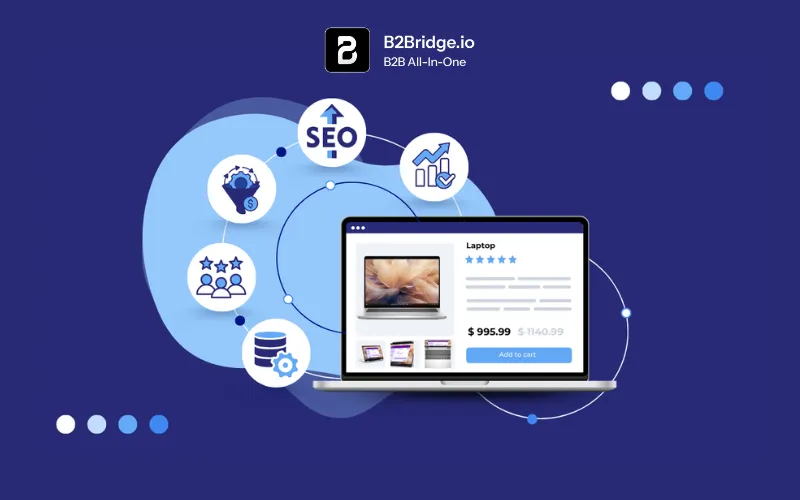In today’s digital-first B2B landscape, effective product catalog management has become the backbone of successful commerce operations. Product catalog management in the B2B context is far more than simply listing products online. Studies show that companies with well-managed product catalogs experience up to 30% faster order processing times and significantly reduced error rates in fulfillment.
This comprehensive guide will walk you through every aspect of B2B product catalog management, from foundational concepts and best practices to cutting-edge technology solutions and measurement strategies. Whether you’re building your first digital catalog or optimizing an existing system, you’ll find actionable insights to transform your product data into a competitive advantage.
What is Product Catalog Management in B2B Context
Product catalog management (PCM) in B2B environments refers to the systematic process of collecting, organizing, standardizing, enriching, and distributing product information across all sales and marketing channels. At its core, PCM serves as the central nervous system of your commercial operations, ensuring that accurate, complete, and consistent product data reaches buyers wherever they interact with your business.
The role of PCM extends far beyond simple data storage. It encompasses data governance, workflow management, quality assurance, and distribution orchestration. A robust PCM system becomes the single source of truth for product information, eliminating the silos and inconsistencies that plague many B2B organizations where product data might exist in fragmented form across ERP systems, spreadsheets, legacy databases, and individual department files.

B2B catalogs possess distinctive characteristics that differentiate them from consumer catalogs. Complex product hierarchies are common, with items organized by industry applications, compatibility requirements, or technical specifications rather than simple category browsing. Custom pricing structures reflect negotiated contracts, volume discounts, customer-specific agreements, and dynamic pricing models that adjust based on market conditions or inventory levels.
Contract-specific catalogs represent another B2B-unique feature. Different customer segments or individual accounts might see entirely different product assortments, pricing, or terms based on their agreements. A national distributor might have access to your full catalog at tier-one pricing, while a regional buyer sees a curated selection with different terms. Managing these variations while maintaining data integrity requires sophisticated catalog management capabilities.
Learn about: Inventory Management: Definition, Benefits, Formula, Techniques & Examples
Key Components of Effective B2B Product Catalogs
Building an effective B2B product catalog requires attention to several critical components that work together to create a seamless buyer experience and efficient operations.
Product Data Quality forms the foundation. This encompasses standardization across all product records, ensuring consistent naming conventions, measurement units, and attribute formatting. Completeness means every product has all required information fields populated – from basic identifiers like SKU and manufacturer part number to detailed specifications, images, documents, and compliance information.
Accuracy ensures the information matches reality, preventing the costly consequences of incorrect specifications or pricing. Data enrichment goes beyond basic requirements, adding value through enhanced descriptions, usage guidelines, application notes, and multimedia content that helps buyers make informed decisions.
Hierarchies and Categorizations determine how easily buyers can navigate your catalog. Effective category trees balance depth and breadth, avoiding overwhelming buyers with too many options while providing enough granularity for precise filtering.
Consider multiple classification schemes: industry-standard taxonomies for broad compatibility, application-based grouping for solution-selling, and attribute-based filtering for technical buyers who search by specifications. Cross-referencing capabilities allow products to appear in multiple relevant categories without data duplication.
Pricing Strategy in B2B catalogs is multifaceted. Tiered pricing structures reward volume purchases with graduated discounts. Contract prices reflect negotiated agreements with specific customers or customer groups.
Customer-specific price visibility ensures buyers see only the pricing relevant to their account, protecting competitive pricing strategies while providing transparency. Dynamic pricing capabilities allow real-time adjustments based on inventory levels, market conditions, or promotional campaigns. The catalog system must handle these complexities while maintaining price integrity and audit trails.
Inventory and Availability information sets accurate expectations. Real-time stock levels prevent overselling and enable buyers to make informed decisions about timing. Lead time indicators help buyers plan around out-of-stock items by showing when products will be available.
Fulfillment indicators specify which warehouse holds inventory, estimated shipping times, and available delivery options. Alternative product suggestions for out-of-stock items help capture sales that might otherwise be lost.
Regulatory and Compliance Metadata is essential for many B2B sectors. Safety data sheets, certification documents, regulatory compliance information, harmonized system codes for international shipping, country-of-origin details, warranty terms, and disposal instructions all need to be readily accessible. This information not only facilitates informed purchasing but also reduces customer support burden and ensures legal compliance.
Modern platforms like B2Bridge provide purpose-built solutions that handle the intricate requirements of B2B commerce – customer-specific catalogs, contract pricing, bulk ordering, and system integration – enabling businesses to launch sophisticated digital catalog experiences without building everything from scratch.
Best Practices for Managing B2B Product Catalogs
Implementing effective product catalog management requires both strategic approach and operational discipline. These best practices have proven successful across industries and company sizes.
Centralize product data into a single source of truth
Fragmented data across multiple systems creates inconsistencies, versioning nightmares, and operational inefficiencies. Establish one authoritative system – typically a Product Information Management (PIM) platform – where all product data is mastered.
Other systems should consume data from this source rather than maintaining their own versions. This centralization dramatically reduces errors, simplifies updates, and ensures consistency across all customer touchpoints.
Integrate PCM with ERP, CRM, and Ecommerce platforms seamlessly
Your catalog doesn’t exist in isolation – it must connect with your broader business systems. Integration with ERP ensures pricing, inventory, and product data stay synchronized. CRM integration enables customer-specific catalog experiences and supports sales team activities. Ecommerce platform integration delivers product information to digital storefronts.
Well-architected integrations eliminate manual data synchronization, reduce errors, and create a cohesive ecosystem. Modern B2B portals like B2Bridge streamline this integration challenge by providing pre-built connections between product catalogs and core business systems, enabling businesses to launch sophisticated digital commerce experiences without extensive custom development.
Automate supplier data feeds and catalog updates where possible
Manual data entry is time-consuming, error-prone, and doesn’t scale. Implement automated integration with supplier systems, manufacturer databases, and distributor feeds. Use APIs, EDI connections, or scheduled file transfers to ingest updates automatically. Automation not only reduces labor costs but also improves data freshness, ensuring your catalog reflects current availability, pricing, and specifications.

Cleanse, normalize, and enrich product data continuously
Data quality is not a one-time project but an ongoing process. Implement automated data quality checks that flag incomplete records, inconsistent formatting, or suspicious values. Establish data governance rules and workflows for addressing quality issues.
Invest in data enrichment – whether through AI-powered tools, third-party data services, or internal subject matter experts – to continuously improve the depth and usefulness of product information.
Design user-centric catalog structures tailored for buyer workflows
Your internal product organization may not align with how customers think about and search for products. Research buyer personas and their typical purchasing journeys. Conduct user testing to understand navigation pain points.
Create category structures, search functionality, and filtering options that match customer mental models. Consider different access paths for different user types: quick reordering for repeat buyers, detailed specifications for engineers, application-focused navigation for solution seekers.
Implement governance with clear roles, workflows, version control, and quality assurance measures
Establish who owns different aspects of product data: who can create new products, who approves pricing changes, who manages technical specifications. Define workflows for product launches, updates, and discontinuations. Maintain version history to track changes and enable rollbacks if needed. Implement approval processes for critical changes. Regular quality audits ensure standards are maintained over time.
Continuously monitor KPIs like data completeness, freshness, and error rates
What gets measured gets managed. Track metrics such as percentage of products with complete required attributes, average time from product receipt to catalog publication, data accuracy rates, and customer-reported data issues. Set targets and implement alerting for significant deviations. Use these metrics to identify improvement opportunities and demonstrate the value of catalog management investments.
Leveraging Technology to Optimize B2B Catalog Management
Technology selection plays a crucial role in successful product catalog management. Understanding the landscape helps you choose solutions aligned with your needs, scale, and resources.
Product Information Management (PIM) systems serve as the cornerstone of modern catalog management. PIM platforms specialize in collecting, managing, enriching, and distributing product information.
Core capabilities include data modeling to accommodate complex product types, workflow management for governance, multi-language support for global operations, digital asset management for images and documents, and syndication capabilities to publish data to multiple channels. Enterprise PIM solutions like Akeneo, inRiver, or Salsify offer comprehensive functionality for complex B2B needs, while mid-market options provide essential capabilities at lower price points.
AI-powered tools are transforming catalog management from a manual discipline to an intelligent, automated process. Machine learning algorithms can predict inventory demand, helping optimize stock levels and prevent shortages. Natural language processing automatically generates or enhances product descriptions, tags products with relevant attributes, and improves search relevance.
Choosing between cloud-based, on-premise, SaaS, and open-source solutions depends on multiple factors. Cloud-based SaaS platforms offer rapid deployment, predictable subscription pricing, automatic updates, and scalability without infrastructure investment. They suit businesses wanting to minimize IT overhead and access latest features quickly.
Syndication capabilities extend your catalog’s reach beyond your owned channels. Publishing to B2B marketplaces like Shopify, Amazon, Alibaba, or industry-specific platforms expands market access. PunchOut catalog integration connects your catalog directly with buyers’ e-procurement systems, enabling seamless purchasing within their familiar workflows.
Print-on-demand generates physical catalogs from digital data for trade shows or customer presentations. API-first architectures allow partners, distributors, or third-party applications to access your product data programmatically. Effective syndication technology automates formatting, transformation, and publishing while maintaining data integrity across all channels.
Enhancing the Buyer Experience with B2B Catalogs
Beyond operational efficiency, product catalog management directly influences buyer satisfaction and conversion rates. Strategic catalog design puts customer needs at the center.
Personalization transforms generic catalogs into tailored experiences. Dynamic catalogs adjust content based on customer profile, displaying products, pricing, and content relevant to each buyer’s industry, role, or purchase history. Customer group-based catalogs show different product assortments to different segments – wholesale buyers see trade prices and bulk packaging, while retail customers see consumer-facing options. Contract-specific catalogs implement negotiated terms automatically, eliminating confusion and support requests. Personalized recommendations based on purchase history, browsing behavior, or similar customer profiles help buyers discover relevant products efficiently.
Search optimization makes finding products effortless. Faceted navigation allows buyers to filter by multiple attributes simultaneously – material type, dimensions, certifications, price range – quickly narrowing thousands of products to relevant options. Synonym handling ensures searches for “wrench” also return “spanner” results. Compatibility filters help buyers find products that work with their existing equipment or systems. Autocomplete suggestions accelerate searching and help buyers discover relevant product terminology. Search analytics reveal what buyers are looking for, informing merchandising and product development decisions.
Interactive elements engage buyers and support decision-making. Product bundles present commonly purchased combinations, increasing average order value while simplifying selection. Comparison tables allow side-by-side evaluation of specifications, pricing, and features across similar products. Related product suggestions surface complementary items, replacement parts, or popular alternatives. Configuration tools help buyers specify complex products with multiple options. 360-degree product views, zoom capabilities, and video demonstrations provide visual confidence traditionally requiring in-person inspection.
Seamless self-service empowers buyers to accomplish tasks independently. Smooth registration and onboarding get new customers up and running quickly. Intuitive ordering processes minimize clicks and friction from product selection through checkout. Quote request functionality for complex or custom products provides clear paths forward when standard ordering doesn’t apply. Repeat order capabilities – quick order by SKU, reorder from history, saved lists – accelerate routine purchases. Order tracking and history provide transparency and support decision-making. Self-service account management lets buyers update information without contacting support.
B2B portal platforms like B2Bridge enable these sophisticated buyer experiences through configurable catalog interfaces designed specifically for complex B2B scenarios, helping businesses deliver consumer-grade digital experiences to their commercial customers.
Real-World Case Studies of Effective B2B Catalog Management
A global automotive parts manufacturer faced significant challenges managing 50,000+ SKUs across 40 countries with technical specifications in 12 languages. Product data existed in multiple ERP systems with inconsistent formats and frequent errors. Catalog updates required weeks, causing missed opportunities and customer frustration. The company implemented an enterprise PIM solution, centralizing all product data with automated workflows for translations and approvals.
Results were transformative: time-to-market for new products decreased by 60%, data accuracy improved to 98%+, and multi-language catalog syndication became fully automated. The manufacturer now launches products simultaneously across all markets, gaining competitive advantage and realizing $2M+ annual operational savings.
A growing B2B wholesale brand selling industrial supplies through their website and marketplace channels struggled with manual catalog management. Product data lived in spreadsheets, requiring hours of manual updates to synchronize across channels. Customer-specific pricing was handled through offline quotes, creating friction and losing impulse purchases.
The company transitioned to a cloud-based PIM with automated syndication capabilities and dynamic pricing rules. Marketplace listings now update automatically, increasing product coverage from 40% to 95% of catalog. Customer-specific pricing displays in real-time based on contract terms. The results: 45% revenue increase, 70% reduction in catalog management time, and significantly improved customer satisfaction scores.
Common Pitfalls and How to Avoid Them in B2B Catalog Management
Even well-intentioned catalog initiatives can stumble. Awareness of common pitfalls helps avoid costly mistakes:
Overcomplex UIs that confuse buyers
Technical teams sometimes design catalogs reflecting internal data structures rather than customer mental models. Avoid this by involving actual buyers in design processes, conducting usability testing, and prioritizing intuitive navigation over comprehensive feature sets.
Neglecting ongoing data updates causing stale and inaccurate information
Initial catalog launches often succeed, but maintaining quality requires sustained effort. Prevent degradation by automating data feeds, implementing governance workflows, assigning clear ownership, and monitoring freshness metrics.
Insufficient metadata management leading to poor product discoverability
Products without proper attributes, categories, or keywords become invisible to searchers. Address this through comprehensive data models, enrichment processes, search analytics to identify gaps, and continuous metadata improvement.
Lack of user training causing adoption issues
Sophisticated catalog tools deliver value only when users understand their capabilities. Invest in training for internal teams managing catalogs and external buyers using them. Provide documentation, video tutorials, and ongoing support.
Underestimating integration complexity
Catalog systems rarely work in isolation. Integration with ERP, Ecommerce, CRM, and other systems often proves more complex and time-consuming than anticipated. Plan carefully, allocate sufficient technical resources, and consider platforms with pre-built integrations.
Ignoring mobile experience
B2B buyers increasingly research and purchase from mobile devices. Catalogs designed only for desktop create friction for on-the-go buyers. Ensure responsive design and mobile-optimized experiences from project inception.
Future Trends Shaping B2B Product Catalog Management
Product catalog management continues evolving as technology advances and buyer expectations rise. Several trends are reshaping the landscape:
AI and machine learning are moving from experimental to mainstream, transforming data enrichment and customer insights
Generative AI creates compelling product descriptions at scale. Predictive analytics forecast demand patterns, optimize inventory, and personalize recommendations with increasing accuracy.
Computer vision automates image tagging and quality control. Natural language processing improves search relevance and enables conversational catalog interfaces. Early adopters report 40-60% productivity gains in catalog management tasks through AI augmentation.
Mobile-responsive and voice-enabled catalog access
Research indicates over 60% of B2B buyers now use mobile devices during purchasing processes. Catalogs must deliver excellent experiences on smartphones and tablets with responsive design, touch-optimized interfaces, and mobile-specific features like barcode scanning. Voice interfaces enable hands-free product lookup and reordering, particularly valuable for warehouse and field personnel. Investment in mobile optimization has become a necessity rather than nice-to-have.
Increasing automation of catalog syndication and order management reduces manual effort and accelerates commerce
API-first architectures enable real-time data synchronization across channels. Automated mapping and transformation adapt product data to different platform requirements without manual intervention. Headless commerce architectures separate product data from presentation, enabling flexible deployment across touchpoints. Order management systems automatically route purchases to optimal fulfillment locations based on inventory, customer location, and business rules.
Greater integration with emerging commerce technologies promises new capabilities
Augmented reality (AR) allows buyers to visualize products in their environments before purchase, particularly valuable for equipment, furniture, or spatial planning. Virtual reality (VR) enables immersive product exploration and virtual showrooms. Blockchain technology offers potential for supply chain transparency, authenticity verification, and automated contract execution through smart contracts. While adoption is still early-stage, forward-thinking B2B organizations are experimenting with these technologies to differentiate their buyer experiences.
FAQs About Product Catalog Management
Effective product catalog management delivers multiple benefits: operational efficiency through centralized data and automated processes, reduced errors in ordering and fulfillment, faster time-to-market for new products, improved customer satisfaction through accurate information and easy discovery, increased sales from better merchandising and personalization, and scalability to support business growth without proportional resource increases. Companies typically see ROI within 12-18 months through a combination of cost savings and revenue improvements.
Selection should consider several factors: business requirements including product complexity, number of SKUs, and multi-channel needs; integration requirements with existing ERP, Ecommerce, and other systems; scalability to support growth; user experience for both catalog managers and end buyers; total cost of ownership including licensing, implementation, and ongoing maintenance; vendor viability and support quality; and deployment preferences (cloud vs. on-premise). Request demos, check references, and consider starting with a pilot project before full commitment.
Update frequency depends on product characteristics and business requirements. Pricing and inventory should update as close to real-time as technically feasible to prevent overselling or incorrect pricing. Product specifications might update quarterly or when changes occur. Descriptive content and enrichment can follow improvement roadmaps. At minimum, establish regular review cycles to ensure data freshness. Automated data feeds enable more frequent updates without proportional effort increases.
B2B-friendly catalogs accommodate complex requirements: customer-specific pricing and product visibility, bulk ordering capabilities, detailed specifications and technical documentation, multi-user accounts with approval workflows, integration with procurement systems, quote and RFQ functionality for complex products, order history and repeat order capabilities, and mobile accessibility for on-the-go buyers. Design should prioritize efficiency and functionality over visual flair, though professional presentation remains important.
Absolutely. Many B2B companies report 20-40% increases in digital channel sales following catalog improvements. The key is viewing catalogs not as static product lists but as active sales tools.
Conclusion
Product catalog management represents a critical competency for B2B organizations navigating today’s complex commercial landscape. Far from being merely a technical exercise in data management, effective PCM influences every aspect of customer experience, operational efficiency, and business growth.
Start with clear objectives, focus on high-impact improvements, leverage appropriate technology, and maintain commitment to quality. Your product catalog, properly managed, becomes not just a list of what you sell but a powerful engine driving customer satisfaction, operational excellence, and sustainable growth.
Ready to transform your B2B product catalog? Discover how B2Bridge’s B2B Portal solutions can help you deliver sophisticated catalog experiences tailored to your customers’ unique needs, with powerful features for personalization, pricing management, and seamless integration with your existing systems. Learn more about B2Bridge today.


Hi, I’m Ha My Phan – an ever-curious digital marketer crafting growth strategies for Shopify apps since 2018. I blend language, logic, and user insight to make things convert. Strategy is my second nature. Learning is my habit. And building things that actually work for people? That’s my favorite kind of win.


